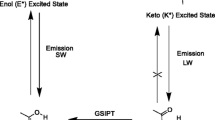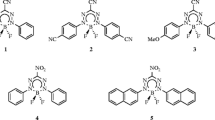Abstract
Density Functional Theory [B3LYP/6-31G(d)] and Time Dependent Density Functional Theory [TD-B3LYP/6-31G(d)] computations have been used to have more understanding of the structural, molecular, electronic and photophysical parameters of recently synthesized near IR-emitting acid switchable di-styryl BODIPY dyes. The structures have been optimized using function B3LYP and basis set used was 6-31G(d) for all the atoms and their geometries which are correlated with corresponding rotational isomers including rotational isomers of diprotonated forms in chloroform solvent. The observed energies of the optimized molecules suggest that there may be rotation about C-C single bond as the observed energy barrier is very low. The results of TD-DFT suggest that there is very good match between the observed and calculated absorptions diprotonated forms of one molecule. There is also good match between experimental and theoretical emission of neutral forms. More deviations are observed in the case emission of the diprotonated forms.



Similar content being viewed by others
References
Treibs A, Kreuzer F-H (1968) Difluorboryl-Komplexe von Di- und Tripyrrylmethenen. Justus Liebigs Ann der Chem 718:208–223. doi:10.1002/jlac.19687180119
Haugland RP (2005) the handbook: a guide to fluorescent probes and labeling technologies, 10th ed. 1126
Coskun A, Akkaya EU (2005) Ion sensing coupled to resonance energy transfer: a highly selective and sensitive ratiometric fluorescent chemosensor for Ag(I) by a modular approach. J Am Chem Soc 127:10464–10465. doi:10.1021/ja052574f
Rurack K, Kollmannsberger M, Resch-Genger U, Daub J (2000) A selective and sensitive fluoroionophore for Hg II, Ag I, and Cu II with virtually decoupled fluorophore and receptor units. J Am Chem Soc 122:968–969. doi:10.1021/ja992630a
Coskun A, Akkaya EU (2006) Signal ratio amplification via modulation of resonance energy transfer: proof of principle in an emission ratiometric Hg(II) sensor. J Am Chem Soc 128:14474–14475. doi:10.1021/ja066144g
Zeng L, Miller EW, Pralle A et al (2006) A selective turn-on fluorescent sensor for imaging copper in living cells. J Am Chem Soc 128:10–11. doi:10.1021/ja055064u
Coskun A, Deniz E, Akkaya EU (2005) Effective PET and ICT switching of boradiazaindacene emission: a unimolecular, emission-mode, molecular half-subtractor with reconfigurable logic gates. Org Lett 7:5187–5189. doi:10.1021/ol052020h
Saki N, Dinc T, Akkaya EU (2006) Excimer emission and energy transfer in cofacial boradiazaindacene (BODIPY) dimers built on a xanthene scaffold. Tetrahedron 62:2721–2725. doi:10.1016/j.tet.2005.12.021
Coskun A, Baytekin BT, Akkaya EU (2003) Novel fluorescent chemosensor for anions via modulation of oxidative PET: a remarkable 25-fold enhancement of emission. Tetrahedron Lett 44:5649–5651. doi:10.1016/S0040-4039(03)01365-0
Ekmekci Z, Yilmaz MD, Akkaya EU (2008) A monostyryl-boradiazaindacene (BODIPY) derivative as colorimetric and fluorescent probe for cyanide ions. Org Lett 10:461–464. doi:10.1021/ol702823u
Li F, Yang SI, Ciringh Y et al (1998) Design, synthesis, and photodynamics of light-harvesting arrays comprised of a porphyrin and one, two, or eight boron-dipyrrin accessory pigments. J Am Chem Soc 120:10001–10017. doi:10.1021/ja9812047
Yilmaz MD, Bozdemir OA, Akkaya EU (2006) Light harvesting and efficient energy transfer in a boron-dipyrrin (BODIPY) functionalized perylenediimide derivative. Org Lett 8:2871–2873. doi:10.1021/ol061110z
Loudet A, Burgess K (2007) BODIPY dyes and their derivatives: syntheses and spectroscopic properties. Chem Rev 107:4891–4932. doi:10.1021/cr078381n
Wood TE, Thompson A (2007) Advances in the chemistry of dipyrrins and their complexes. Chem Rev 107:1831–1861. doi:10.1021/cr050052c
Ziessel R, Ulrich G, Harriman A (2007) The chemistry of Bodipy: a new El Dorado for fluorescence tools. New J Chem 31:496. doi:10.1039/b617972j
Weissleder R (2001) A clearer vision for in vivo imaging. Nat Biotechnol 19:316–317. doi:10.1038/86684
Burghart A, Kim H, Welch MB et al (1999) 3,5-Diaryl-4,4-difluoro-4-bora-3a,4a-diaza-s-indacene (BODIPY) Dyes: synthesis, spectroscopic, electrochemical, and structural properties. J Org Chem 64:7813–7819. doi:10.1021/jo990796o
Yamada K, Toyota T, Takakura K et al (2001) Preparation of BODIPY probes for multicolor fluorescence imaging studies of membrane dynamics. New J Chem 25:667–669. doi:10.1039/b100757m
Killoran J, Allen L, Gallagher JF, et al. (2002) Synthesis of BF2 chelates of tetraarylazadipyrromethenes and evidence for their photodynamic therapeutic behaviour. Chemical Communications 1862–1863. doi: 10.1039/b204317c
Gorman A, Killoran J, O’Shea C et al (2004) In vitro demonstration of the heavy-atom effect for photodynamic therapy. J Am Chem Soc 126:10619–10631. doi:10.1021/ja047649e
Chen J, Burghart A, Derecskei-Kovacs A, Burgess K (2000) 4,4-Difluoro-4-bora-3a,4a-diaza- s -indacene (BODIPY) dyes modified for extended conjugation and restricted bond rotations. J Org Chem 65:2900–2906. doi:10.1021/jo991927o
Zhao W, Carreira EM (2005) Conformationally restricted aza-bodipy: a highly fluorescent, stable, near-infrared-absorbing dye. Angew Chem (Int ed Engl) 44:1677–1679. doi:10.1002/anie.200461868
Zhao W, Carreira EM (2006) Conformationally restricted aza-BODIPY: highly fluorescent, stable near-infrared absorbing dyes. Chem (Weinheim Bergstrasse, Germany) 12:7254–7263. doi:10.1002/chem.200600527
Chen J, Burghart A, Wan C-W et al (2000) Synthesis and spectroscopic properties of 2-ketopyrrole–BF2 complexes: a new class of fluorescent dye. Tetrahedron Lett 41:2303–2307. doi:10.1016/S0040-4039(00)00166-0
Wada M, Ito S, Uno H et al (2001) Synthesis and optical properties of a new class of pyrromethene–BF2 complexes fused with rigid bicyclo rings and benzo derivatives. Tetrahedron Lett 42:6711–6713. doi:10.1016/S0040-4039(01)01299-0
Shen Z, Röhr H, Rurack K et al (2004) Boron-diindomethene (BDI) dyes and their tetrahydrobicyclo precursors--en route to a new class of highly emissive fluorophores for the red spectral range. Chem (Weinheim Bergstrasse, Germany) 10:4853–4871. doi:10.1002/chem.200400173
Goeb S, Ziessel R (2007) Convenient synthesis of green diisoindolodithienylpyrromethene-dialkynyl borane dyes. Org Lett 9:737–740. doi:10.1021/ol0627404
Umezawa K, Nakamura Y, Makino H et al (2008) Bright, color-tunable fluorescent dyes in the visible-near-infrared region. J Am Chem Soc 130:1550–1551. doi:10.1021/ja077756j
Rurack K, Kollmannsberger M, Daub J (2001) Molecular switching in the near infrared (NIR) with a functionalized boron-dipyrromethene dye this work was supported by the Deutsche Forschungsgemeinschaft (Da 92/24-1). Angew Chem (Int ed Engl) 40:385–387. doi:10.1002/1521-3773
Atilgan S, Ekmekci Z, Dogan AL, et al. (2006) Water soluble distyryl-boradiazaindacenes as efficient photosensitizers for photodynamic therapy. Chemical communications (Cambridge, England) 4398–400. doi:10.1039/b612347c
Deniz E, Isbasar GC, Bozdemir OA et al (2008) Bidirectional switching of near IR emitting boradiazaindacene fluorophores. Org Lett 10:3401–3403. doi:10.1021/ol801062h
Atilgan S, Ozdemir T, Akkaya EU (2008) A sensitive and selective ratiometric near IR fluorescent probe for zinc ions based on the distyryl-bodipy fluorophore. Org Lett 10:4065–4067. doi:10.1021/ol801554t
Atilgan S, Kutuk I, Ozdemir T (2010) A near IR di-styryl BODIPY-based ratiometric fluorescent chemosensor for Hg(II). Tetrahedron Lett 51:892–894. doi:10.1016/j.tetlet.2009.12.025
Zhang X, Xiao Y, Qi J et al (2013) Long-wavelength, photostable, two-photon excitable BODIPY fluorophores readily modifiable for molecular probes. J Org Chem 78:9153–9160. doi:10.1021/jo401379g
Zhao C, Zhang Y, Wang X, Cao J (2013) Development of BODIPY-based fluorescent DNA intercalating probes. J Photochem Photobiol A Chem 264:41–47
Zheng Q, Xu G, Prasad PN (2008) Conformationally restricted dipyrromethene boron difluoride (BODIPY) dyes: highly fluorescent, multicolored probes for cellular imaging. Chem (Weinheim Bergstrasse, Germany) 14:5812–5819. doi:10.1002/chem.200800309
Puntoriero F, Nastasi F, Bura T et al (2011) Molecular logics: a mixed bodipy–bipyridine dye behaving as a concealable molecular switch. New J Chem 35:948. doi:10.1039/c0nj00770f
Kolemen S, Bozdemir OA, Cakmak Y et al (2011) Optimization of distyryl-Bodipy chromophores for efficient panchromatic sensitization in dye sensitized solar cells. Chem Sci 2:949. doi:10.1039/c0sc00649a
Kolemen S, Cakmak Y, Erten-Ela S et al (2010) Solid-state dye-sensitized solar cells using red and near-IR absorbing Bodipy sensitizers. Org Lett 12:3812–3815. doi:10.1021/ol1014762
Erten-Ela S, Yilmaz MD, Icli B et al (2008) A panchromatic boradiazaindacene (BODIPY) sensitizer for dye-sensitized solar cells. Org Lett 10:3299–3302. doi:10.1021/ol8010612
Zhao Y, Zhang Y, Lv X et al (2011) Through-bond energy transfer cassettes based on coumarin–Bodipy/distyryl Bodipy dyads with efficient energy efficiences and large pseudo-Stokes’ shifts. J Mater Chem 21:13168. doi:10.1039/c1jm12503f
Guliyev R, Coskun A, Akkaya EU (2009) Design strategies for ratiometric chemosensors: modulation of excitation energy transfer at the energy donor site. J Am Chem Soc 131:9007–9013. doi:10.1021/ja902584a
Eggenspiller A, Takai A, El-Khouly ME et al (2012) Synthesis and photodynamics of fluorescent blue BODIPY-porphyrin tweezers linked by triazole rings. J Phys Chem A 116:3889–3898. doi:10.1021/jp300415a
Qin W, Baruah M, De Borggraeve WM, Boens N (2006) Photophysical properties of an on/off fluorescent pH indicator excitable with visible light based on a borondipyrromethene-linked phenol. J Photochem Photobiol A Chem 183:190–197. doi:10.1016/j.jphotochem.2006.03.015
Rurack K, Kollmannsberger M, Daub J (2001) Molekulares Schalten im nahen Infrarot (NIR) mit einem funktionalisierten Bordipyrromethen-Farbstoff. Angew Chem 113:396–399. doi:10.1002/1521-3757(20010119)113:2<396::AID-ANGE396>3.0.CO;2-W
Frisch MJ, Trucks GW, Schlegel HB, et al. (2009) Gaussian 09 C.01
Treutler O, Ahlrichs R (1995) Efficient molecular numerical integration schemes. J Chem Phys 102:346. doi:10.1063/1.469408
Becke AD (1993) A new mixing of Hartree–Fock and local density-functional theories. J Chem Phys 98:1372. doi:10.1063/1.464304
Lee C, Yang W, Parr RG (1988) Development of the Colle-Salvetti correlation-energy formula into a functional of the electron density. Phys Rev B 37:785–789. doi:10.1103/PhysRevB.37.785
Hehre WJ (1976) Ab initio molecular orbital theory. Acc Chem Res 9:399–406. doi:10.1021/ar50107a003
Bauernschmitt R, Ahlrichs R (1996) Treatment of electronic excitations within the adiabatic approximation of time dependent density functional theory. Chem Phys Lett 256:454–464. doi:10.1016/0009-2614(96)00440-X
Furche F, Rappoport D (2005) Computational photochemistry (Google eBook). 368
Gabe Y, Ueno T, Urano Y et al (2006) Tunable design strategy for fluorescence probes based on 4-substituted BODIPY chromophore: improvement of highly sensitive fluorescence probe for nitric oxide. Anal Bioanal Chem 386:621–626. doi:10.1007/s00216-006-0587-y
Furche F, Ahlrichs R (2002) Adiabatic time-dependent density functional methods for excited state properties. J Chem Phys 117:7433. doi:10.1063/1.1508368
Leszczynski J, Shukla M (2009) Practical aspects of computational chemistry: methods. Concepts Appl (Google eBook) 484
Scalmani G, Frisch MJ, Mennucci B et al (2006) Geometries and properties of excited states in the gas phase and in solution: theory and application of a time-dependent density functional theory polarizable continuum model. J Chem Phys 124:94107. doi:10.1063/1.2173258
Valeur B, Berberan-Santos MN (2013) Molecular fluorescence: principles and applications (Google eBook), 2 nd. 500
Cossi M, Barone V, Cammi R, Tomasi J (1996) Ab initio study of solvated molecules: a new implementation of the polarizable continuum model. Chem Phys Lett 255:327–335. doi:10.1016/0009-2614(96)00349-1
Tomasi J, Mennucci B, Cammi R (2005) Quantum mechanical continuum solvation models. Chem Rev 105:2999–3093. doi:10.1021/cr9904009
Acknowledgments
One of the authors, Kishor G. Thorat, is very thankful to CSIR for financial assistance.
Author information
Authors and Affiliations
Corresponding authors
Electronic supplementary material
Below is the link to the electronic supplementary material.
ESM 1
(DOCX 3.39 mb)
Rights and permissions
About this article
Cite this article
Thorat, K.G., Bhakhoa, H., Ramasami, P. et al. NIR-Emitting Boradiazaindacene Fluorophores -TD-DFT Studies on Electronic Structure and Photophysical Properties. J Fluoresc 25, 69–78 (2015). https://doi.org/10.1007/s10895-014-1481-1
Received:
Accepted:
Published:
Issue Date:
DOI: https://doi.org/10.1007/s10895-014-1481-1




